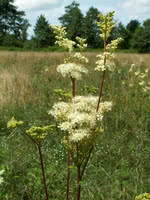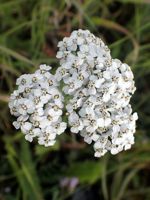Mon-Fri 9am - 5pm Mountain time
Meadowsweet vs Yarrow
Filipendula ulmaria
Achillea borealis (Previously Achillea millefolium)
ONLY AVAILABLE BY CONTRACT GROW
NOT AVAILABLE THIS SEASON
(new stock expected: fall of 2026)
Meadowsweet gets its name from its sweet fragrance from the creamy white flowers. It is a large upright herbaceous perennial shrub. They bloom in early summer, and with the right conditions may remain throughout the season.
Take care of where you’re planting Meadowsweet as it is known to spread.
Yarrow is a herbaceous, native wildflower that is found across Canada. It features large, flat clusters of tiny white flowers. The blooms attract a variety of pollinators, making it an ideal choice for pollinator gardens. While partial shade is tolerated, the best flowering occurs in full sun. Yarrow is resistant to deer and rabbits, making it both a beautiful and practical addition to your landscape.
The entire plant is edible, but leaves and flowers are most commonly consumed. They have a strong licorice scent and a mild sweet flavor that is similar to tarragon. Yarrow leaves can also be used as a natural insect repellent.
It is important to plant Yarrow in the right place, it can spread quickly via both rhizomes and self-seeding. Deadheading the spent flowers will extend the bloom season and can help limit self-seeding.
Meadowsweet Quick Facts
Yarrow Quick Facts
Toxicity: toxic to dogs, cats, and horses

